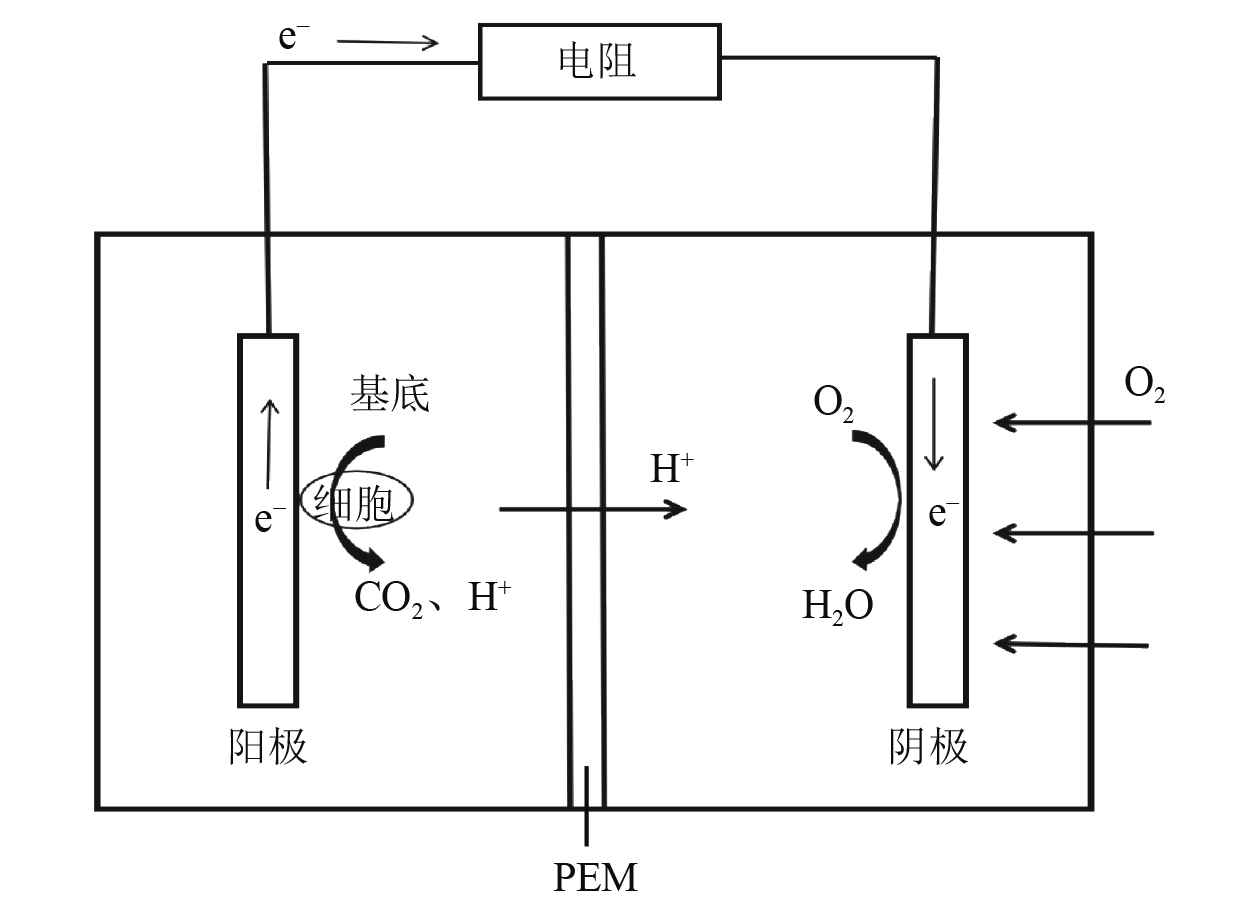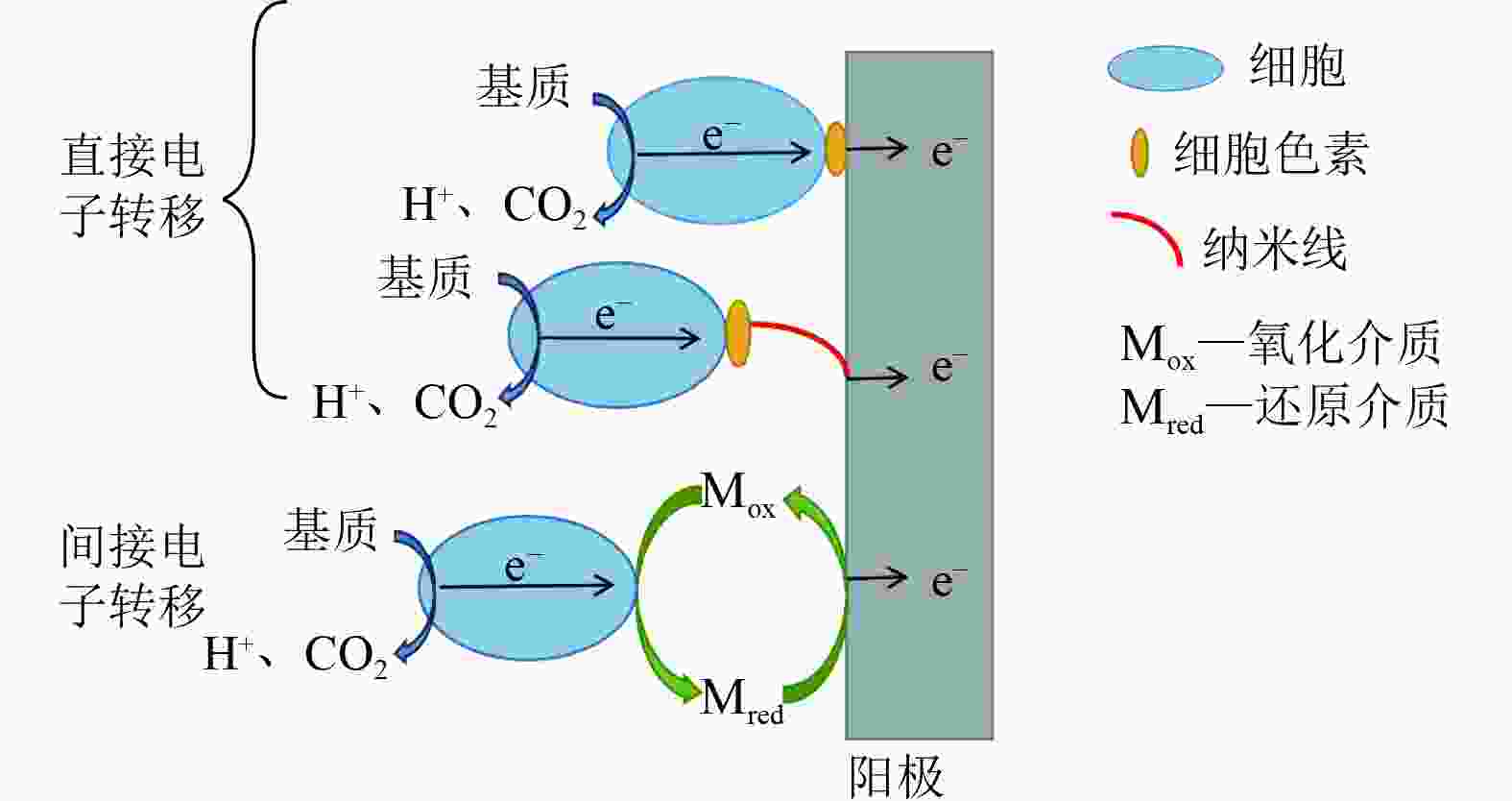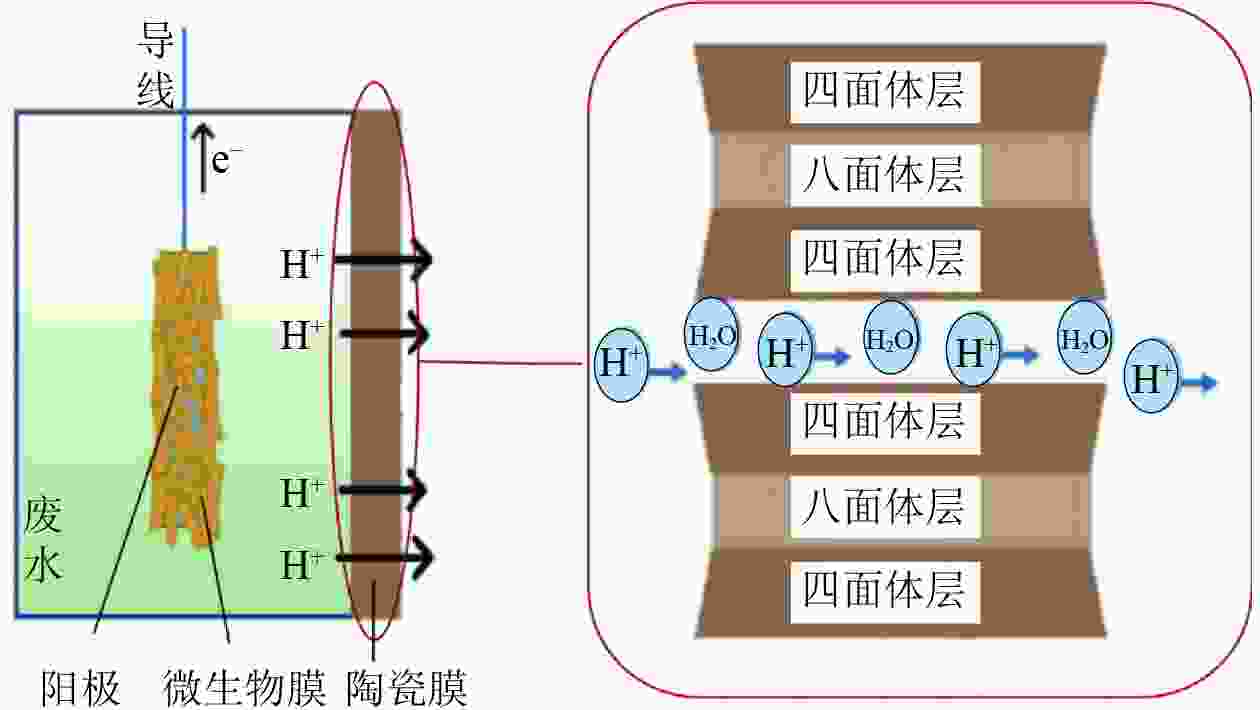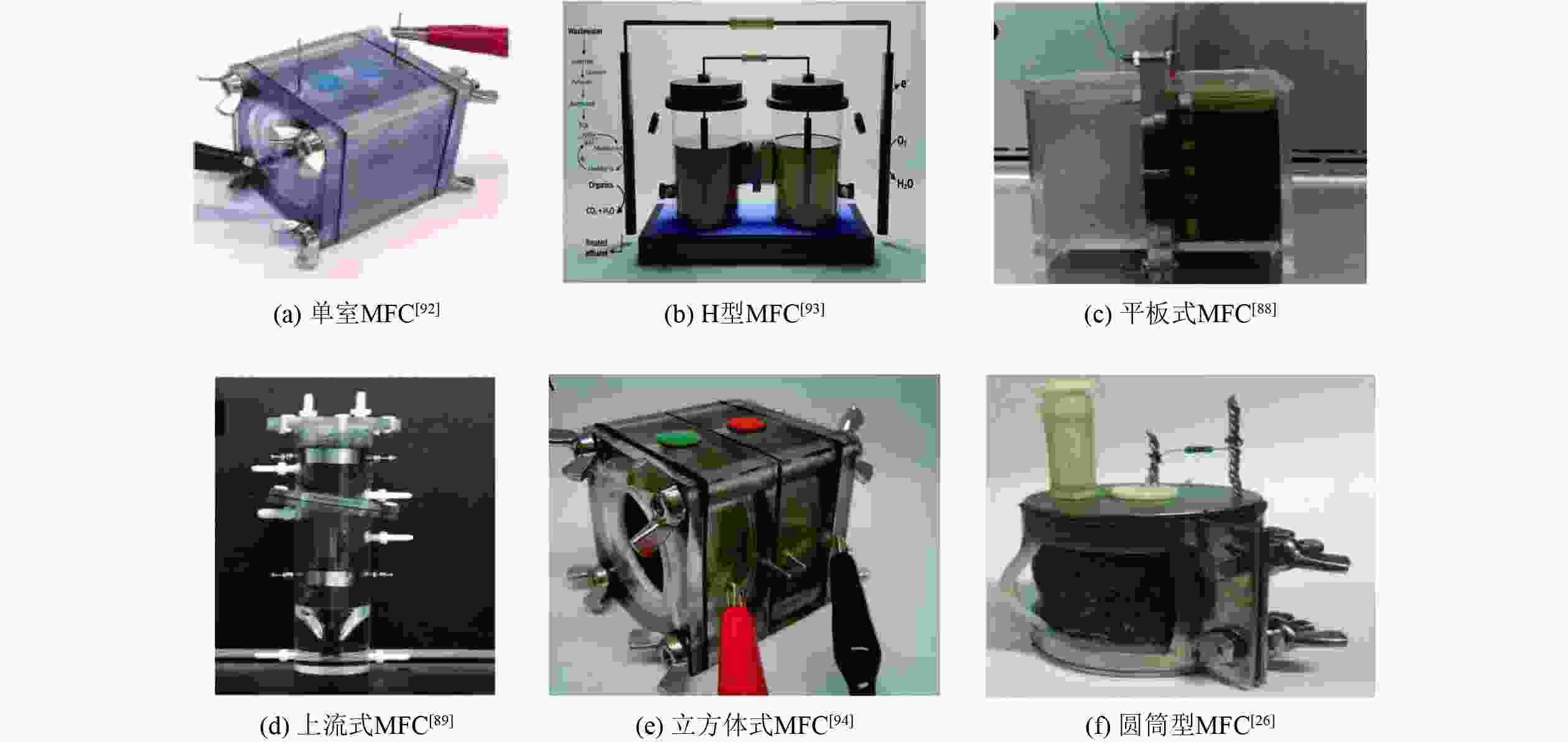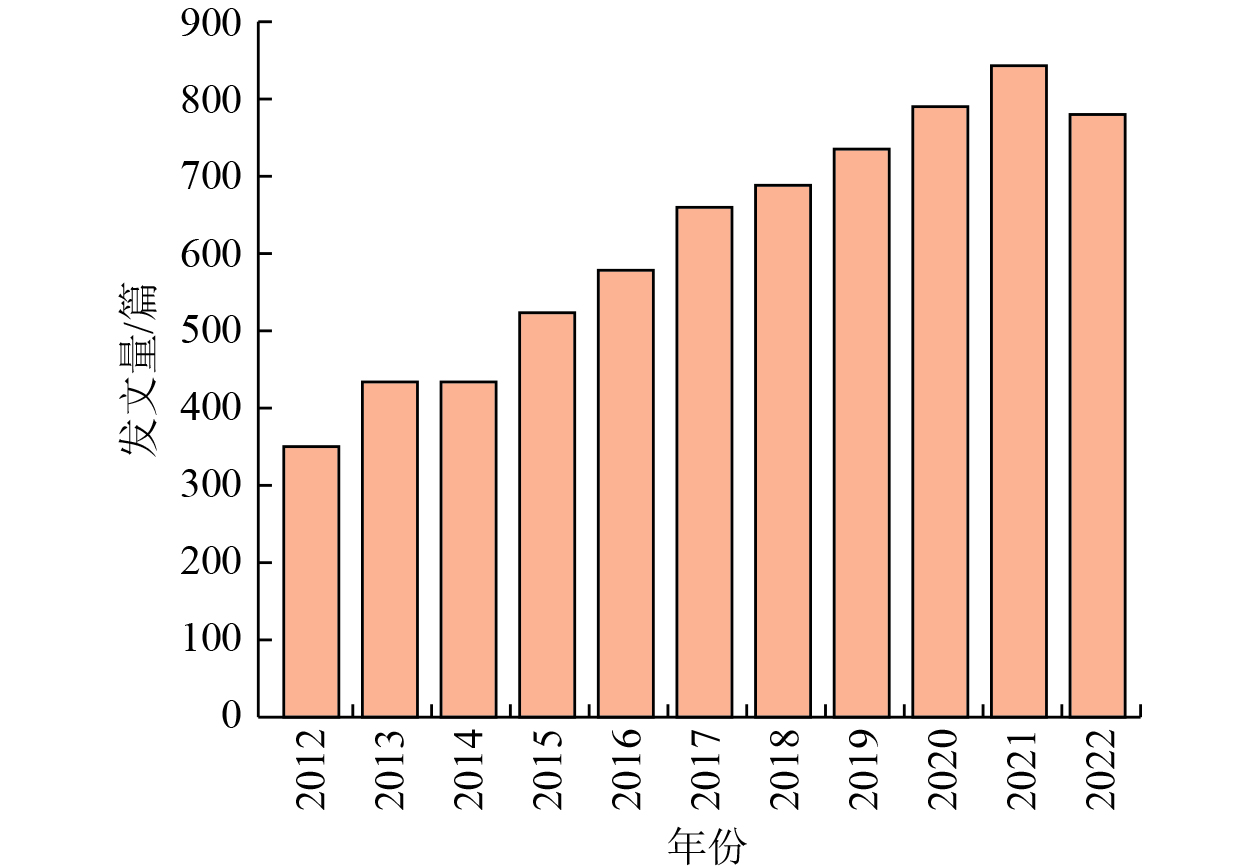Working principle of microbial fuel cell and strategies for enhancing power generation performance
-
摘要:
微生物燃料电池(MFC)是一种解决其他能源在环境方面不足的新技术,目前低能量输出是MFC实际应用的关键瓶颈。基于MFC工作原理,提出微生物活性差、电子迁移阻力、质子传输阻力及阴极还原反应缓慢是MFC能量输出的限制因素,并从以下5个方面综述了提升MFC产电性能策略:调节pH和选择最佳盐度,加强微生物代谢活性;改性阳极材料,降低电子迁移阻力;增强电解液电导率、优化隔膜材料及缩短电极间距减小质子传输阻力;制备高效阴极催化剂和选择优异电子受体加快阴极还原反应速率;改进MFC反应器构型,提高整体产电性能。未来,可在合成新型阴极催化剂、降低膜污染、优化微生物生长环境、制备优异的电极材料和改进MFC反应器配置5个方面开展重点研究。
-
关键词:
- 微生物燃料电池(MFC) /
- 产电性能 /
- 输出功率 /
- 微生物活性 /
- 策略
Abstract:Microbial fuel cell (MFC) is a new technology that addresses the environmental deficiencies of other energy sources. At present, low energy output is a key bottleneck in the practical application of MFC. Based on the working principle of MFC, it was proposed that poor microbial activity, resistance to electron migration, proton transfer resistance, slow cathodic reduction reaction were the limiting factors for the energy output of MFC. The strategies for improving MFC electricity production performance were summarized from the following five aspects: adjusting pH and selecting the optimal salinity to enhance microbial metabolic activity; modifying anode materials to reduce electron migration resistance; enhancing electrolyte conductivity, optimizing membrane materials, and shortening electrode spacing to reduce proton transfer resistance; preparing efficient cathode catalysts and selecting excellent electron acceptors to accelerate the cathodic reduction reaction rate; and improving the configuration of MFC reactor to improve overall power generation performance. In the future, key research could be carried out in five areas, including synthesis of new cathode catalysts, reduction of membrane pollution, optimization of microbial growth environment, preparation of excellent electrode materials, and improvement of MFC reactor configuration.
-
图 2 MFC工作原理示意[26]
Figure 2. Schematic diagram of MFC working principle
图 3 阳极电子转移示意[43]
Figure 3. Schematic diagram of anode electron transfer
图 4 双室MFC中陶瓷膜传递质子结构示意[54]
Figure 4. Schematic diagram of proton transfer structure through ceramic membranes in dual chamber MFC
图 5 ORR的2种途径[81]
Figure 5. Two ways of ORR
表 1 MFC结构
Table 1. Structure of MFC
组件 组成和功能 阳极室 由阳极电极和微生物组成,容纳污水,
是微生物降解底物的场所阴极室 由阴极电极和电催化剂组成,是
阴极还原反应发生的场所阳极 一般采用碳基电极作为阳极电极,如碳布或碳纸,阳极电极
与金属丝连接,以收集细菌氧化过程中产生的电子,
并将电子提供给阴极电极阴极 通常采用涂有活性催化剂的碳基电极作为阴极电极,将各
种铂、非铂、杂原子掺杂的催化剂用作还原反应催化剂,
以加速阴极还原反应动力学电解液 从阳极室到阴极室产生的质子由电解液转移 燃料 各种有机来源均可作为MFC的燃料,
如生活污水和各种工业废水微生物 将底物氧化为CO2,产生电子,并将电子
从电池内部转移到阳极表面[20]隔膜 阻隔阳极室和阴极室,具有传导质子的作用 表 2 MFC影响因素及对应措施
Table 2. MFC influencing factors and corresponding measures
序号 工作原理 限速步骤 影响因素 策略方法 1 阳极室中微生物分解废水中有机物,产生CO2、H+和电子 底物降解 微生物
活性调节pH或选择最佳盐度 2 电子从微生物传递到阳极,并通过外电路传递到阴极,从而产生电流 电子转移 阳极材料 改性阳极材料 3 H+通过隔膜从阳极
到达阴极质子传递 膜 优化膜材料 电极间距 缩短电极间距 电解液 加强电解液
电导率4 在阴极上H+与电子受
体和电子反应生成水阴极还原反应 催化剂 制备高效
催化剂电子受体 选择优异电子受体 表 3 不同MFC反应器构型的优缺点
Table 3. Advantages and disadvantages of different MFC configurations
MFC构型 优点 缺点 单室MFC 结构简单,采用空气阴极,直接以O2作为电子受体,
不需定期更换阴极电解液,两极间距小只有1个电极室,不利于单独研究,有的缺乏质子交换膜的隔离,
阴极催化剂容易受到微生物的污染[95]H型MFC 保证了两极室的空间独立性,避免了相互干扰 电极间距大,传质阻力大,需要人工曝气,
溶解氧浓度低,氧还原反应动力学缓慢平板型MFC 采用PEM电极组件,电极间距较短,促进了电极之间的质子转移[96],
最大限度减少了内阻;两极室采用蛇形流场板,
强化了液体流动,增强了物质基质的传输[97]O2容易渗透到阳极 上流式MFC 提高了阳极接触面积,不用设搅拌设备[98] 人工曝气额外消耗能量,溶解氧浓度低 圆筒形MFC 离子交换膜面积大,电极间距小,启动快,
电池阻抗低;阳极上附着的生物量多,电化学活性高[90]人工曝气额外消耗能量,溶解氧浓度低 表 4 不同MFC反应器构型产电性能
Table 4. Electricity generation performance of different MFC reactor configurations
MFC类型 是否
存在
PEM电极
间距/
cmPEM
面积/
cm2离子
强度/
(mmol/L)内阻/Ω 功率密度/
(W/m2)数据
来源单室 是 4 16 68 390 0.354 文献[20] 是 0 16 68 120 1.18 文献[20] H型双室 是 12 7 68 1 800 0.031 文献[20] 是 10 6 1.7 310±65 0.069 文献[86] 否 5 1.7 200±50 0.23 文献[52] 平板式 是 0 3.9 45.3±6.5 12.9 文献[99] 上流式 17 29.2 文献[100] 84 3.1 文献[89] 圆筒型 否 1 50 49.66 1.364 文献[101] -
[1] JADHAV D A, CARMONA-MARTÍNEZ A A, CHENDAKE A D, et al. Modeling and optimization strategies towards performance enhancement of microbial fuel cells[J]. Bioresource Technology,2021,320:124256. doi: 10.1016/j.biortech.2020.124256 [2] 徐戴非, 吴兵党, 杨晶晶, 等. 藻炭改性电极强化微生物燃料电池产电及去除硝基苯性能[J]. 环境工程技术学报,2023,13(6):2092-2104. doi: 10.12153/j.issn.1674-991X.20230092XU D F, WU B D, YANG J J, et al. Removal efficiency of nitrobenzene and electricity generation by microbial fuel cell with algal biochar modified electrode[J]. Journal of Environmental Engineering Technology,2023,13(6):2092-2104. doi: 10.12153/j.issn.1674-991X.20230092 [3] 操家顺, 贺含悦, 李超, 等. 不同方式预处理污泥对微生物燃料电池的影响[J]. 环境科学研究,2018,31(8):1389-1398.CAO J S, HE H Y, LI C, et al. Effects of different pretreatments on sludge in microbial fuel cell[J]. Research of Environmental Sciences,2018,31(8):1389-1398. [4] 綦琪, 王许云, 贾云. 微生物燃料电池电极材料研究进展[J]. 科技导报,2015,33(14):28-31. doi: 10.3981/j.issn.1000-7857.2015.14.004QI Q, WANG X Y, JIA Y. Latest research development of electrode materials for microbial fuel cells[J]. Science & Technology Review,2015,33(14):28-31. doi: 10.3981/j.issn.1000-7857.2015.14.004 [5] PANDEY P, SHINDE V N, DEOPURKAR R L, et al. Recent advances in the use of different substrates in microbial fuel cells toward wastewater treatment and simultaneous energy recovery[J]. Applied Energy,2016,168:706-723. doi: 10.1016/j.apenergy.2016.01.056 [6] WEE J H. Applications of proton exchange membrane fuel cell systems[J]. Renewable and Sustainable Energy Reviews,2007,11(8):1720-1738. doi: 10.1016/j.rser.2006.01.005 [7] LIU J G, MOONEY H, HULL V, et al. Systems integration for global sustainability[J]. Science,2015,347(6225):e1258832. doi: 10.1126/science.1258832 [8] 陈立香, 肖勇, 赵峰. 微生物燃料电池生物阴极[J]. 化学进展,2012,24(1):157-162.CHEN L X, XIAO Y, ZHAO F. Biocathodes in microbial fuel cells[J]. Progress in Chemistry,2012,24(1):157-162. [9] SINGH D, PRATAP D, BARANWAL Y, et al. A green technology for power generation[J]. Annals of Biological Research,2010,1(3):128-138. [10] VENKATA MOHAN S, MOHANAKRISHNA G, REDDY B P, et al. Bioelectricity generation from chemical wastewater treatment in mediatorless (anode) microbial fuel cell (MFC) using selectively enriched hydrogen producing mixed culture under acidophilic microenvironment[J]. Biochemical Engineering Journal,2008,39(1):121-130. doi: 10.1016/j.bej.2007.08.023 [11] DU Z W, LI H R, GU T Y. A state of the art review on microbial fuel cells: a promising technology for wastewater treatment and bioenergy[J]. Biotechnology Advances,2007,25(5):464-482. doi: 10.1016/j.biotechadv.2007.05.004 [12] DURRUTY I, BONANNI P S, GONZÁLEZ J F, et al. Evaluation of potato-processing wastewater treatment in a microbial fuel cell[J]. Bioresource Technology,2012,105:81-87. doi: 10.1016/j.biortech.2011.11.095 [13] PARKHEY P, SAHU R. Microfluidic microbial fuel cells: recent advancements and future prospects[J]. International Journal of Hydrogen Energy,2021,46(4):3105-3123. doi: 10.1016/j.ijhydene.2020.07.019 [14] JADHAV D A, MUNGRAY A K, ARKATKAR A, et al. Recent advancement in scaling-up applications of microbial fuel cells: from reality to practicability[J]. Sustainable Energy Technologies and Assessments,2021,45:101226. doi: 10.1016/j.seta.2021.101226 [15] 李朝明, 许丹, 黄铭意, 等. 不同阳极设置对人工湿地-微生物燃料电池脱氮及产能的影响[J]. 环境工程技术学报,2023,13(1):205-213. doi: 10.12153/j.issn.1674-991X.20220048LI C M, XU D, HUANG M Y, et al. Effects of different anode settings on the performance of nitrogen removal and electrogenesis capacity in constructed wetland-microbial fuel cells[J]. Journal of Environmental Engineering Technology,2023,13(1):205-213. doi: 10.12153/j.issn.1674-991X.20220048 [16] 孔晓英, 李连华, 孙永明, 等. 微生物燃料电池产能原理及输出功率的影响因素[J]. 现代化工,2007,27(增刊2):282-284. [17] 顾熠澐. 微生物燃料电池输出功率影响因素综述[J]. 水电与新能源,2014(2):69-74.GU Y Y. Output power and its influencing factors of microbial fuel cells: a review[J]. Hydropower and New Energy,2014(2):69-74. [18] JUNG S P, PANDIT S. Important factors influencing microbial fuel cell performance[M]//Microbial electrochemical technology. Amsterdam: Elsevier, 2019: 377-406. [19] CHEN S L, PATIL S A, BROWN R K, et al. Strategies for optimizing the power output of microbial fuel cells: transitioning from fundamental studies to practical implementation[J]. Applied Energy,2019,233/234:15-28. doi: 10.1016/j.apenergy.2018.10.015 [20] Liang P, Huang X, Fan M Z, et al. Composition and distribution of internal resistance in three types of microbial fuel cells[J]. Applied Microbiology and Biotechnology, 2007, 77: 551-558. [21] ABOURACHED C, ENGLISH M J, LIU H. Wastewater treatment by microbial fuel cell (MFC) prior irrigation water reuse[J]. Journal of Cleaner Production,2016,137:144-149. doi: 10.1016/j.jclepro.2016.07.048 [22] 崔康平, 金松. 微生物燃料电池阳极室内电子受体竞争研究[J]. 环境科学研究,2010,23(1):90-93.CUI K P, JIN S. Competition between electron acceptors in anodic chamber of microbial fuel cells[J]. Research of Environmental Sciences,2010,23(1):90-93. [23] 赵阳, 宋永会, 段亮. 微生物燃料电池降低活化内阻和欧姆内阻技术研究进展[J]. 环境工程技术学报,2021,11(2):343-353. doi: 10.12153/j.issn.1674-991X.20200167ZHAO Y, SONG Y H, DUAN L. Technical research progress of reducing activation internal resistance and ohmic internal resistance in microbial fuel cells[J]. Journal of Environmental Engineering Technology,2021,11(2):343-353. doi: 10.12153/j.issn.1674-991X.20200167 [24] WANG S Q, TIAN S, ZHANG P Y, et al. Enhancement of biological oxygen demand detection with a microbial fuel cell using potassium permanganate as cathodic electron acceptor[J]. Journal of Environmental Management,2019,252:109682. doi: 10.1016/j.jenvman.2019.109682 [25] NACHAMMAI K T, RAMACHANDRAN S, NAGARAJAN C, et al. Exploration of bioinformatics on microbial fuel cell technology: trends, challenges, and future prospects[J]. Journal of Chemistry,2023,2023:6902054. [26] RISMANI-YAZDI H, CARVER S M, CHRISTY A D, et al. Cathodic limitations in microbial fuel cells: an overview[J]. Journal of Power Sources,2008,180(2):683-694. doi: 10.1016/j.jpowsour.2008.02.074 [27] 王维大, 李浩然, 冯雅丽, 等. 微生物燃料电池的研究应用进展[J]. 化工进展,2014,33(5):1067-1076. doi: 10.3969/j.issn.1000-6613.2014.05.001WANG W D, LI H R, FENG Y L, et al. Research and application advances in microbial fuel cell[J]. Chemical Industry and Engineering Progress,2014,33(5):1067-1076. doi: 10.3969/j.issn.1000-6613.2014.05.001 [28] LOGAN B E, REGAN J M. Microbial fuel cells: challenges and applications[J]. Environmental Science & Technology,2006,40(17):5172-5180. [29] ZHOU M H, CHI M L, LUO J M, et al. An overview of electrode materials in microbial fuel cells[J]. Journal of Power Sources,2011,196(10):4427-4435. doi: 10.1016/j.jpowsour.2011.01.012 [30] LIU H, CHENG S A, LOGAN B E. Power generation in fed-batch microbial fuel cells as a function of ionic strength, temperature, and reactor configuration[J]. Environmental Science & Technology,2005,39(14):5488-5493. [31] ZHANG E R, LIU L, CUI Y Y. Effect of pH on the performance of the anode in microbial fuel cells[J]. Advanced Materials Research,2012,608/609:884-888. doi: 10.4028/www.scientific.net/AMR.608-609.884 [32] YUAN Y, ZHAO B, ZHOU S G, et al. Electrocatalytic activity of anodic biofilm responses to pH changes in microbial fuel cells[J]. Bioresource Technology,2011,102(13):6887-6891. doi: 10.1016/j.biortech.2011.04.008 [33] 段亮, 李世龙, 邢飞. 正渗透微生物燃料电池反向溶质通量和膜污染控制技术研究进展[J]. 环境工程技术学报,2023,13(3):1150-1160. doi: 10.12153/j.issn.1674-991X.20220593DUAN L, LI S L, XING F. Technical research progress of controlling reverse solute flux and membrane fouling in osmotic microbial fuel cell[J]. Journal of Environmental Engineering Technology,2023,13(3):1150-1160. doi: 10.12153/j.issn.1674-991X.20220593 [34] BEHERA M, GHANGREKAR M M. Performance of microbial fuel cell in response to change in sludge loading rate at different anodic feed pH[J]. Bioresource Technology,2009,100(21):5114-5121. doi: 10.1016/j.biortech.2009.05.020 [35] KUMAR S S, KUMAR V, GNANESWAR GUDE V, et al. Alkalinity and salinity favor bioelectricity generation potential of Clostridium, Tetrathiobacter and Desulfovibrio consortium in microbial fuel cells (MFC) treating sulfate-laden wastewater[J]. Bioresource Technology,2020,306:123110. doi: 10.1016/j.biortech.2020.123110 [36] GUO F, LUO H Q, SHI Z Y, et al. Substrate salinity: a critical factor regulating the performance of microbial fuel cells, a review[J]. Science of the Total Environment,2021,763:143021. doi: 10.1016/j.scitotenv.2020.143021 [37] OH S E, LOGAN B E. Proton exchange membrane and electrode surface areas as factors that affect power generation in microbial fuel cells[J]. Applied Microbiology and Biotechnology,2006,70(2):162-169. doi: 10.1007/s00253-005-0066-y [38] LOGAN B E, ROSSI R, RAGAB A, et al. Electroactive microorganisms in bioelectrochemical systems[J]. Nature Reviews Microbiology,2019,17:307-319. doi: 10.1038/s41579-019-0173-x [39] ALI YAQOOB A, IBRAHIM M N M, RODRÍGUEZ-COUTO S. Development and modification of materials to build cost-effective anodes for microbial fuel cells (MFCs): an overview[J]. Biochemical Engineering Journal,2020,164:107779. doi: 10.1016/j.bej.2020.107779 [40] HE L, DU P, CHEN Y Z, et al. Advances in microbial fuel cells for wastewater treatment[J]. Renewable and Sustainable Energy Reviews,2017,71:388-403. doi: 10.1016/j.rser.2016.12.069 [41] CI S Q, WEN Z H, CHEN J H, et al. Decorating anode with bamboo-like nitrogen-doped carbon nanotubes for microbial fuel cells[J]. Electrochemistry Communications,2012,14(1):71-74. doi: 10.1016/j.elecom.2011.11.006 [42] HUGGINS T, WANG H M, KEARNS J, et al. Biochar as a sustainable electrode material for electricity production in microbial fuel cells[J]. Bioresource Technology,2014,157:114-119. doi: 10.1016/j.biortech.2014.01.058 [43] AIYER K S. How does electron transfer occur in microbial fuel cells[J]. World Journal of Microbiology and Biotechnology,2020,36(2):19. doi: 10.1007/s11274-020-2801-z [44] MEHDINIA A, ZIAEI E, JABBARI A. Multi-walled carbon nanotube/SnO2 nanocomposite: a novel anode material for microbial fuel cells[J]. Electrochimica Acta,2014,130:512-518. doi: 10.1016/j.electacta.2014.03.011 [45] WEI J C, LIANG P, HUANG X. Recent progress in electrodes for microbial fuel cells[J]. Bioresource Technology,2011,102(20):9335-9344. doi: 10.1016/j.biortech.2011.07.019 [46] KUMAR G G, SATHIYA SARATHI V G, NAHM K S. Recent advances and challenges in the anode architecture and their modifications for the applications of microbial fuel cells[J]. Biosensors and Bioelectronics,2013,43:461-475. doi: 10.1016/j.bios.2012.12.048 [47] ZHU Y X, JI J Y, REN J Y, et al. Conductive multilayered polyelectrolyte films improved performance in microbial fuel cells (MFCs)[J]. Colloids and Surfaces A:Physicochemical and Engineering Aspects,2014,455:92-96. [48] CHOU H T, LEE H J, LEE C Y, et al. Highly durable anodes of microbial fuel cells using a reduced graphene oxide/carbon nanotube-coated scaffold[J]. Bioresource Technology,2014,169:532-536. doi: 10.1016/j.biortech.2014.07.027 [49] PARK I H, CHRISTY M, KIM P, et al. Enhanced electrical contact of microbes using Fe3O4/CNT nanocomposite anode in mediator-less microbial fuel cell[J]. Biosensors and Bioelectronics,2014,58:75-80. doi: 10.1016/j.bios.2014.02.044 [50] KANG C S, EAKTASANG N, KWON D Y, et al. Enhanced current production by Desulfovibrio desulfuricans biofilm in a mediator-less microbial fuel cell[J]. Bioresource Technology,2014,165:27-30. doi: 10.1016/j.biortech.2014.03.148 [51] WU X Y, TONG F, SONG T S, et al. Effect of zeolite-coated anode on the performance of microbial fuel cells[J]. Journal of Chemical Technology & Biotechnology,2015,90(1):87-92. [52] SCOTT K, RIMBU G A, KATURI K P, et al. Application of modified carbon anodes in microbial fuel cells[J]. Process Safety and Environmental Protection,2007,85(5):481-488. doi: 10.1205/psep07018 [53] WEN Z H, CI S Q, MAO S, et al. TiO2 nanoparticles-decorated carbon nanotubes for significantly improved bioelectricity generation in microbial fuel cells[J]. Journal of Power Sources,2013,234:100-106. doi: 10.1016/j.jpowsour.2013.01.146 [54] VIDHYESWARI D, SURENDHAR A, BHUVANESHWARI S. General aspects and novel PEMss in microbial fuel cell technology: a review[J]. Chemosphere,2022,309:136454. doi: 10.1016/j.chemosphere.2022.136454 [55] WANG X, CHENG S A, ZHANG X Y, et al. Impact of salinity on cathode catalyst performance in microbial fuel cells (MFCs)[J]. International Journal of Hydrogen Energy,2011,36(21):13900-13906. doi: 10.1016/j.ijhydene.2011.03.052 [56] AARON D, TSOURIS C, HAMILTON C Y, et al. Assessment of the effects of flow rate and ionic strength on the performance of an air-cathode microbial fuel cell using electrochemical impedance spectroscopy[J]. Energies,2010,3(4):592-606. doi: 10.3390/en3040592 [57] TAMAKLOE R Y, DONKOR M K E, SINGH K. Fabrication and study of power- output of MultiChamber microbial fuel cells (MFCs) with clay as ion exchange partition[J]. European Scientific Journal, ESJ,2017,13(30):173. doi: 10.19044/esj.2017.v13n30p173 [58] ZHOU G Y, YOSHINO Y, YAMASHITA T, et al. Effect of anode size, membrane and membrane size on power generation and wastewater treatment in microbial fuel cells[J]. Applied Mechanics and Materials,2012,164:506-510. doi: 10.4028/www.scientific.net/AMM.164.506 [59] LIU H, LOGAN B E. Electricity generation using an air-cathode single chamber microbial fuel cell in the presence and absence of a proton exchange membrane[J]. Environmental Science & Technology,2004,38(14):4040-4046. [60] JANICEK A, FAN Y Z, LIU H. Design of microbial fuel cells for practical application: a review and analysis of scale-up studies[J]. Biofuels,2014,5(1):79-92. doi: 10.4155/bfs.13.69 [61] 马骏, 苏冬云, 濮海坤, 等. 微生物燃料电池反应器构型设计[J]. 电源技术,2015,39(10):2318-2320. doi: 10.3969/j.issn.1002-087X.2015.10.084MA J, SU D Y, PU H K, et al. Reactor configuration design of microbial fuel cell[J]. Chinese Journal of Power Sources,2015,39(10):2318-2320. doi: 10.3969/j.issn.1002-087X.2015.10.084 [62] FLIMBAN S G A, HASSAN S H A, RAHMAN M M, et al. The effect of Nafion membrane fouling on the power generation of a microbial fuel cell[J]. International Journal of Hydrogen Energy,2020,45(25):13643-13651. doi: 10.1016/j.ijhydene.2018.02.097 [63] ZHANG X Y, CHENG S A, WANG X, et al. Separator characteristics for increasing performance of microbial fuel cells[J]. Environmental Science & Technology,2009,43(21):8456-8461. [64] GIL G C, CHANG I S, KIM B H, et al. Operational parameters affecting the performannce of a mediator-less microbial fuel cell[J]. Biosensors and Bioelectronics,2003,18(4):327-334. doi: 10.1016/S0956-5663(02)00110-0 [65] DAUD S M, KIM B H, GHASEMI M, et al. Separators used in microbial electrochemical technologies: current status and future prospects[J]. Bioresource Technology,2015,195:170-179. doi: 10.1016/j.biortech.2015.06.105 [66] YANG E, CHAE K J, CHOI M J, et al. Critical review of bioelectrochemical systems integrated with membrane-based technologies for desalination, energy self-sufficiency, and high-efficiency water and wastewater treatment[J]. Desalination,2019,452:40-67. doi: 10.1016/j.desal.2018.11.007 [67] PARK D H, ZEIKUS J G. Improved fuel cell and electrode designs for producing electricity from microbial degradation[J]. Biotechnology and Bioengineering,2003,81(3):348-355. doi: 10.1002/bit.10501 [68] PEIGHAMBARDOUST S J, ROWSHANZAMIR S, AMJADI M. Review of the proton exchange membranes for fuel cell applications[J]. International Journal of Hydrogen Energy,2010,35(17):9349-9384. doi: 10.1016/j.ijhydene.2010.05.017 [69] BEHERA M, GHANGREKAR M M. Electricity generation in low cost microbial fuel cell made up of earthenware of different thickness[J]. Water Science & Technology,2011,64(12):2468-2473. doi: 10.2166/wst.2011.822 [70] TAMBOLI E, ESWARI J. Microbial fuel cell configurations[J/OL]. Microbial Electrochemical Technology, 2019. DOI: 10.1016/B978-0-444-64052-9.00016-9. [71] HOU B, SUN J, HU Y Y. Simultaneous Congo red decolorization and electricity generation in air-cathode single-chamber microbial fuel cell with different microfiltration, ultrafiltration and proton exchange membranes[J]. Bioresource Technology,2011,102(6):4433-4438. doi: 10.1016/j.biortech.2010.12.092 [72] SANGEETHA T, MUTHUKUMAR M. Influence of electrode material and electrode distance on bioelectricity production from sago-processing wastewater using microbial fuel cell[J]. Environmental Progress & Sustainable Energy,2013,32(2):390-395. [73] GHANGREKAR M M, SHINDE V B. Performance of membrane-less microbial fuel cell treating wastewater and effect of electrode distance and area on electricity production[J]. Bioresource Technology,2007,98(15):2879-2885. doi: 10.1016/j.biortech.2006.09.050 [74] PAPILLON J, ONDEL O, MAIRE É. Scale up of single-chamber microbial fuel cells with stainless steel 3D anode: effect of electrode surface areas and electrode spacing[J]. Bioresource Technology Reports,2021,13:100632. doi: 10.1016/j.biteb.2021.100632 [75] CHENG S A, LIU H, LOGAN B E. Increased power generation in a continuous flow MFC with advective flow through the porous anode and reduced electrode spacing[J]. Environmental Science & Technology,2006,40(7):2426-2432. [76] NIE Y, LI L, WEI Z D. Recent advancements in Pt and Pt-free catalysts for oxygen reduction reaction[J]. Chemical Society Reviews,2015,44(8):2168-2201. doi: 10.1039/C4CS00484A [77] YU D S, NAGELLI E, DU F, et al. Metal-free carbon nanomaterials become more active than metal catalysts and last longer[J]. The Journal of Physical Chemistry Letters,2010,1(14):2165-2173. doi: 10.1021/jz100533t [78] ERABLE B, FÉRON D, BERGEL A. Microbial catalysis of the oxygen reduction reaction for microbial fuel cells: a review[J]. ChemSusChem,2012,5(6):975-987. doi: 10.1002/cssc.201100836 [79] GAUTAM R K, BHATTACHARJEE H, VENKATA M S, et al. Nitrogen doped graphene supported α-MnO2 nanorods for efficient ORR in a microbial fuel cell[J]. RSC Advances,2016,6(111):110091-110101. doi: 10.1039/C6RA23392A [80] XIA Z H, AN L, CHEN P K, et al. Oxygen reduction: non-Pt nanostructured catalysts for oxygen reduction reaction: synthesis, catalytic activity and its key factors[J]. Advanced Energy Materials,2016,6(17):1670104. [81] STACY J, REGMI Y N, LEONARD B, et al. The recent progress and future of oxygen reduction reaction catalysis: a review[J]. Renewable and Sustainable Energy Reviews,2017,69:401-414. doi: 10.1016/j.rser.2016.09.135 [82] PANDIT S, SENGUPTA A, KALE S, et al. Performance of electron acceptors in catholyte of a two-chambered microbial fuel cell using anion exchange membrane[J]. Bioresource Technology,2011,102(3):2736-2744. doi: 10.1016/j.biortech.2010.11.038 [83] YOU S J, ZHAO Q L, ZHANG J N, et al. A microbial fuel cell using permanganate as the cathodic electron acceptor[J]. Journal of Power Sources,2006,162(2):1409-1415. doi: 10.1016/j.jpowsour.2006.07.063 [84] LI J, FU Q, LIAO Q, et al. Persulfate: a self-activated cathodic electron acceptor for microbial fuel cells[J]. Journal of Power Sources,2009,194(1):269-274. doi: 10.1016/j.jpowsour.2009.04.055 [85] OH S, MIN B, LOGAN B E. Cathode performance as a factor in electricity generation in microbial fuel cells[J]. Environmental Science & Technology,2004,38(18):4900-4904. [86] LI F X, SHARMA Y, LEI Y, et al. Microbial fuel cells: the effects of configurations, electrolyte solutions, and electrode materials on power generation[J]. Applied Biochemistry and Biotechnology,2010,160(1):168-181. doi: 10.1007/s12010-008-8516-5 [87] LOGAN B E, HAMELERS B, ROZENDAL R, et al. Microbial fuel cells: methodology and technology[J]. Environmental Science & Technology,2006,40(17):5181-5192. [88] SAMARASINGHE N, LONGTIN N, FERNANDO S. Performance of Methylococcus capsulatus based microbial and enzymatic proton exchange membrane fuel cells[J]. Renewable Energy,2022,195:17-27. doi: 10.1016/j.renene.2022.06.023 [89] HE Z, MINTEER S D, ANGENENT L T. Electricity generation from artificial wastewater using an upflow microbial fuel cell[J]. Environmental Science & Technology,2005,39(14):5262-5267. [90] 刘春梅, 廖强, 叶丁丁, 等. 矩形与双筒型微生物燃料电池产电特性比较[J]. 电源技术,2015,39(9):1891-1894. doi: 10.3969/j.issn.1002-087X.2015.09.028LIU C M, LIAO Q, YE D D, et al. Comparison of electricity generation performance of rectangular and tubular microbial fuel cells[J]. Chinese Journal of Power Sources,2015,39(9):1891-1894. doi: 10.3969/j.issn.1002-087X.2015.09.028 [91] BOND D R, LOVLEY D R. Electricity production by Geobacter sulfurreducens attached to electrodes[J]. Applied and Environmental Microbiology,2003,69(3):1548-1555. doi: 10.1128/AEM.69.3.1548-1555.2003 [92] 赵世辉. 双室型微生物燃料电池在制浆废水处理中的应用研究[D]. 广州: 华南理工大学, 2011. [93] ABUBACKAR H N, BIRYOL İ, AYOL A. Yeast industry wastewater treatment with microbial fuel cells: effect of electrode materials and reactor configurations[J]. International Journal of Hydrogen Energy,2023,48(33):12424-12432. doi: 10.1016/j.ijhydene.2022.05.277 [94] CHENG S A, DEMPSEY B A, LOGAN B E. Electricity generation from synthetic acid-mine drainage (AMD) water using fuel cell technologies[J]. Environmental Science & Technology,2007,41(23):8149-8153. [95] SONG Y E, LEE S, KIM M, et al. Metal-free cathodic catalyst with nitrogen- and phosphorus-doped ordered mesoporous carbon (NPOMC) for microbial fuel cells[J]. Journal of Power Sources,2020,451:227816. doi: 10.1016/j.jpowsour.2020.227816 [96] VARANASI J L, PRASAD S, SINGH H, et al. Improvement of bioelectricity generation and microalgal productivity with concomitant wastewater treatment in flat-plate microbial carbon capture cell[J]. Fuel,2020,263:116696. doi: 10.1016/j.fuel.2019.116696 [97] 张军. 微生物燃料电池阳极构型及其物质传输强化和产电特性[D]. 重庆: 重庆大学, 2015. [98] 赵立新, 邹立军, 王宣, 等. 以葡萄糖为燃料的上流式单室微生物燃料电池[J]. 大庆石油学院学报,2010,34(1):76-79.ZHAO L X, ZOU L J, WANG X, et al. An up-flow single-chamber microbial fuel cell using glucose as fuel[J]. Journal of Daqing Petroleum Institute,2010,34(1):76-79. [99] PARK Y, PARK S, NGUYEN V K, et al. Complete nitrogen removal by simultaneous nitrification and denitrification in flat-panel air-cathode microbial fuel cells treating domestic wastewater[J]. Chemical Engineering Journal,2017,316:673-679. doi: 10.1016/j.cej.2017.02.005 [100] HE Z, WAGNER N, MINTEER S D, et al. An upflow microbial fuel cell with an interior cathode: assessment of the internal resistance by impedance spectroscopy[J]. Environmental Science & Technology,2006,40(17):5212-5217. [101] ZHANG M, MA Z K, ZHAO N, et al. Increased power generation from cylindrical microbial fuel cell inoculated with P. aeruginosa[J]. Biosensors and Bioelectronics,2019,141:111394. ◇ doi: 10.1016/j.bios.2019.111394 -




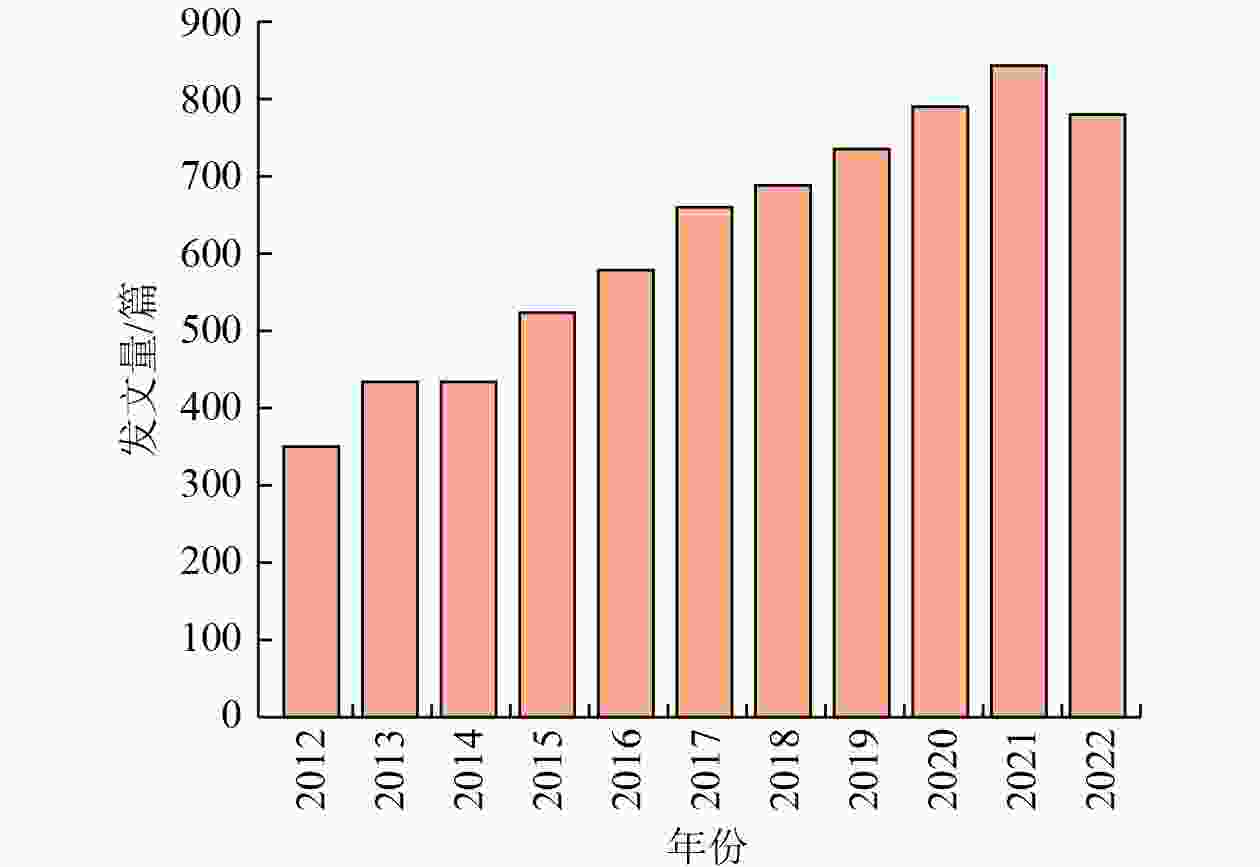
 下载:
下载:
